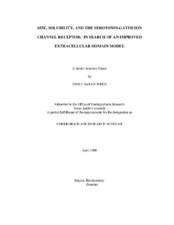| dc.description.abstract | The 5-HT3 receptor (5-HT3R) is the only serotonin receptor that is not a G-coupled protein receptor. It has been implicated as a contributor to cytotoxic drug-evoked emesis, irritable bowel syndrome, pruritis, schizophrenia, Parkinson disease, addiction, bulimia, nociception, and problems with cognitive function. It follows that improved, more specific 5-HT3R antagonists are an attractive goal for the pharmaceutical industry. Current models of the 5-HT3R are based on homology to the highly structurally related and well studied nicotinic acetylcholine receptor, but no high resolution image of the full length 5-HT3R has yet been determined. This research works towards development of an extracellular domain model, which would be a better candidate for x-ray crystallography and NMR spectroscopy due to its higher water solubility and smaller size. Constructs of the mouse 5-HT3R were made with an N-terminal mAb-142 epitope tag for immunoblotting with a linker region to promote flexibility of the tag in the extracellular domain. A Kozak sequence was incorporated to optimize expression in Xenopus oocytes. Designs included a full length construct; a construct truncated after the first transmembrane domain with valine substituted for an intra-membrane aspartic acid residue; and constructs terminated after the extracellular domain, after the first transmembrane domain, and directly preceding the third transmembrane domain. Binding assays with [3H]-granisetron showed significant binding only with the full length construct, though minimal binding was observed with the construct with the valine substitution. These results suggest that elements present in the other parts of the native receptor may be vital to efficient ligand binding and should be included in the design of a successful truncated model. | en |


